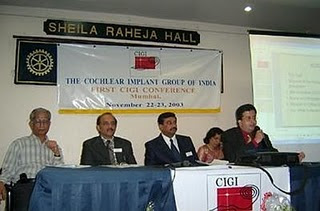3rd Part of Article
Manufacture:
 Currently (as of 2007 update), the three cochlear implant devices approved for use in the U.S. are manufactured by Cochlear Limited, Australia, MED-EL, Austria and Advanced Bionics, US. In the EU, an additional device manufactured by Neural, of France is available. Each manufacturer has adapted some of the successful innovations of the other companies to their own devices. There is no clear-cut consensus that any one of these implants is superior to the others. Users of all four devices display a wide range of performance after implantation.
Currently (as of 2007 update), the three cochlear implant devices approved for use in the U.S. are manufactured by Cochlear Limited, Australia, MED-EL, Austria and Advanced Bionics, US. In the EU, an additional device manufactured by Neural, of France is available. Each manufacturer has adapted some of the successful innovations of the other companies to their own devices. There is no clear-cut consensus that any one of these implants is superior to the others. Users of all four devices display a wide range of performance after implantation. Since the devices have a similar range of outcomes, other criteria are often considered when choosing a cochlear implant: usability of external components, cosmetic factors, battery life, reliability of the internal and external components, MRI compatibility, mapping strategies, customer service from the manufacturer, the familiarity of the user's surgeon and audiologist with the particular device, and anatomical concerns.
Since the devices have a similar range of outcomes, other criteria are often considered when choosing a cochlear implant: usability of external components, cosmetic factors, battery life, reliability of the internal and external components, MRI compatibility, mapping strategies, customer service from the manufacturer, the familiarity of the user's surgeon and audiologist with the particular device, and anatomical concerns.Cochlear's 2007 annual report acknowledges that a Federal investigation continues into its payments to physicians and providers. In February 2007, part of the whistleblower complaint against Cochlear filed by former Chief Financial Officer Brenda March was unsealed by the U.S. District Court for the District of Colorado. The complaint alleges that Cochlear violated the Federal anti-kickback statute through its Partners Program, which offered credits towards free or discounted products for physicians who implanted Cochlear devices, as well as gifts, trips, and other gratuities paid to physicians and providers. The government intervened in the case and transferred it from the U.S. Department of Justice to the Health and Human Services Inspector General for the imposition of civil penalties. The amounts of sanctions are not yet known.
What are the Benefits of Cochlear Implants?:
For people with implants:
Hearing ranges from near normal ability to understand speech to no hearing benefit at all. Adults often benefit immediately and continue to improve for about 3 months after the initial tuning sessions. Then, although performance continues to improve, improvements are slower. Cochlear implant users' performances may continue to improve for several years. Children may improve at a slower pace. A lot of training is needed after implantation to help the child use the new 'hearing' he or she now experiences.
Most perceive loud, medium and soft sounds. People report that they can perceive different types of sounds, such as footsteps, slamming of doors, sounds of engines, ringing of the telephone, barking of dogs, whistling of the tea kettle, rustling of leaves, the sound of a light switch being switched on and off, and so on. Many understand speech without lip-reading. However, even if this is not possible, using the implant helps lip-reading.
Hearing ranges from near normal ability to understand speech to no hearing benefit at all. Adults often benefit immediately and continue to improve for about 3 months after the initial tuning sessions. Then, although performance continues to improve, improvements are slower. Cochlear implant users' performances may continue to improve for several years. Children may improve at a slower pace. A lot of training is needed after implantation to help the child use the new 'hearing' he or she now experiences.
Most perceive loud, medium and soft sounds. People report that they can perceive different types of sounds, such as footsteps, slamming of doors, sounds of engines, ringing of the telephone, barking of dogs, whistling of the tea kettle, rustling of leaves, the sound of a light switch being switched on and off, and so on. Many understand speech without lip-reading. However, even if this is not possible, using the implant helps lip-reading.
Many can make telephone calls and understand familiar voices over the telephone. Some good performers can make normal telephone calls and even understand an unfamiliar speaker. However, not all people who have implants are able to use the phone. Many can watch TV more easily, especially when they can also see the speaker's face. However, listening to the radio is often more difficult as there are no visual cues available. Some can enjoy music. Some enjoy the sound of certain instruments (piano or guitar, for example) and certain voices. Others do not hear well enough to enjoy music.
What are the Risks of Cochlear Implants?
What are the Risks of Cochlear Implants?
General Anesthesia Risks:
General anesthesia is drug-induced sleep. The drugs, such as anesthetic gases and injected drugs, may affect people differently. For most people, the risk of general anesthesia is very low. However, for some people with certain medical conditions, it is more risky.
Risks from the Surgical Implant Procedure:
Injury to the facial nerve --this nerve goes through the middle ear to give movement to the muscles of the face. It lies close to where the surgeon needs to place the implant, and thus it can be injured during the surgery. An injury can cause a temporary or permanent weakening or full paralysis on the same side of the face as the implant.
Meningitis:
General anesthesia is drug-induced sleep. The drugs, such as anesthetic gases and injected drugs, may affect people differently. For most people, the risk of general anesthesia is very low. However, for some people with certain medical conditions, it is more risky.
Risks from the Surgical Implant Procedure:
Injury to the facial nerve --this nerve goes through the middle ear to give movement to the muscles of the face. It lies close to where the surgeon needs to place the implant, and thus it can be injured during the surgery. An injury can cause a temporary or permanent weakening or full paralysis on the same side of the face as the implant.
Meningitis:
This is an infection of the lining of the surface of the brain. People who have abnormally formed inner ear structures appear to be at greater risk of this rare, but serious complication. For more information on the risk of meningitis in cochlear recipients,
Cerebrospinal fluid leakage:
Cerebrospinal fluid leakage:
The brain is surrounded by fluid that may leak from a hole created in the inner ear or elsewhere from a hole in the covering of the brain as a result of the surgical procedure.Perilymph fluid leak:
The inner ear or cochlea contains fluid. This fluid can leak through the hole that was created to place the implant;
The inner ear or cochlea contains fluid. This fluid can leak through the hole that was created to place the implant;
Infection of the skin wound;
Blood or fluid collection at the site of surgery;
Attacks of dizziness or vertigo;
Tinnitus, which is a ringing or buzzing sound in the ear;
A taste disturbance; the nerve that gives taste sensation to the tongue also goes through the middle ear and might be injured during the surgery.
Numbness around the ear;
Reparative granuloma; this is the result of localized inflammation that can occur if the body rejects the implant. There may be other unforeseen complications that could occur with long term implantation that we cannot now predict.
Other Risks Associated with the Use of Cochlear Implants:
People with a cochlear implant: May hear sounds differently. Sound impressions from an implant differ from normal hearing, according to people who could hear before they became deaf. At first, users describe the sound as "mechanical", "technical", or "synthetic". This perception changes over time, and most users do not notice this artificial sound quality after a few weeks of cochlear implant use.
Blood or fluid collection at the site of surgery;
Attacks of dizziness or vertigo;
Tinnitus, which is a ringing or buzzing sound in the ear;
A taste disturbance; the nerve that gives taste sensation to the tongue also goes through the middle ear and might be injured during the surgery.
Numbness around the ear;
Reparative granuloma; this is the result of localized inflammation that can occur if the body rejects the implant. There may be other unforeseen complications that could occur with long term implantation that we cannot now predict.
Other Risks Associated with the Use of Cochlear Implants:
People with a cochlear implant: May hear sounds differently. Sound impressions from an implant differ from normal hearing, according to people who could hear before they became deaf. At first, users describe the sound as "mechanical", "technical", or "synthetic". This perception changes over time, and most users do not notice this artificial sound quality after a few weeks of cochlear implant use.
May lose residual hearing; The implant may destroy any remaining hearing in the implanted ear.
May have unknown and uncertain effects. The cochlear implant stimulates the nerves directly with electrical currents. Although this stimulation appears to be safe, the long term effect of these electrical currents on the nerves is unknown.
May not hear as well as others, who have had successful outcomes with their implants;
May not be able to understand language well. There is no test a person can take before surgery that will predict how well he or she will understand language after surgery;
May have to have it removed temporarily or permanently if an infection develops after the implant surgery. However, this is a rare complication.
May have their implant fail. In this situation, a person with an implant would need to have additional surgery to resolve this problem and would be exposed to the risks of surgery again;
May not be able to upgrade their implant when new external components become available. Implanted parts are usually compatible with improved external parts. That way, as advances in technology develop, one can upgrade his or her implant by changing only its external parts. In some cases, though, this won't work and the implant will need changing;
May not be able to have some medical examinations and treatments;
These treatments include:
MRI imaging: MRI is becoming a more routine diagnostic method for early detection of medical problems. Even being close to an MRI imaging unit will be dangerous because it may dislodge the implant or demagnetize its internal magnet. FDA has approved some implants, however, for some types of MRI studies done under controlled conditions.
These treatments include:
MRI imaging: MRI is becoming a more routine diagnostic method for early detection of medical problems. Even being close to an MRI imaging unit will be dangerous because it may dislodge the implant or demagnetize its internal magnet. FDA has approved some implants, however, for some types of MRI studies done under controlled conditions.
Neurostimulation.
Electrical surgery.
Electroconvulsive therapy.
Ionic radiation therapy.
Will depend on batteries for hearing.
For some devices new or recharged batteries are needed every day.
May damage their implant.
Contact sports, automobile accidents, slips and falls, or other impacts near the ear can damage the implant.
This may mean needing a new implant and more surgery. It is unknown whether a new implant would work as well as the old one.
May find them expensive. Replacing damaged or lost parts may be expensive.Will have to use it for the rest of life. During a person's lifetime, the manufacturer of the cochlear implant could go out of business.
Whether a person will be able to get replacement parts or other customer service in the future is uncertain.
May have lifestyle changes because their implant will interact with the electronic environment.
An implant may Set off theft detection systems;
Set off metal detectors or other security systems;
Be affected by cellular phone users or other radio transmitters;
Have to be turned off during take offs and landings in aircraft;
Interact in unpredictable ways with other computer systems;
Will have to be careful of static electricity;
Static electricity may temporarily or permanently damage a cochlear implant.
It may be good practice to remove the processor and headset before contact with static generating materials such as children's plastic play equipment, TV screens, computer monitors, or synthetic fabric. For more details regarding how to deal with static electricity, contact the manufacturer or implant center.
Have less ability to hear both soft sounds and loud sounds without changing the sensitivity of the implant. The sensitivity of normal hearing is adjusted continuously by the brain, but the design of cochlear implants requires that a person manually change sensitivity setting of the device as the sound environment changes.May develop irritation where the external part rubs on the skin and have to remove it for a while.
Can't let the external parts get wet. Damage from water may be expensive to repair and the person may be without hearing until the implant is repaired. Thus, the person will need to remove the external parts of the device when bathing, showering, swimming, or participating in water sports. May hear strange sounds caused by its interaction with magnetic fields, like those near airport passenger screening machines.
It may be good practice to remove the processor and headset before contact with static generating materials such as children's plastic play equipment, TV screens, computer monitors, or synthetic fabric. For more details regarding how to deal with static electricity, contact the manufacturer or implant center.
Have less ability to hear both soft sounds and loud sounds without changing the sensitivity of the implant. The sensitivity of normal hearing is adjusted continuously by the brain, but the design of cochlear implants requires that a person manually change sensitivity setting of the device as the sound environment changes.May develop irritation where the external part rubs on the skin and have to remove it for a while.
Can't let the external parts get wet. Damage from water may be expensive to repair and the person may be without hearing until the implant is repaired. Thus, the person will need to remove the external parts of the device when bathing, showering, swimming, or participating in water sports. May hear strange sounds caused by its interaction with magnetic fields, like those near airport passenger screening machines.







